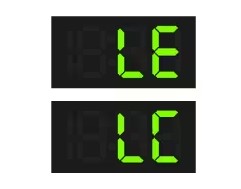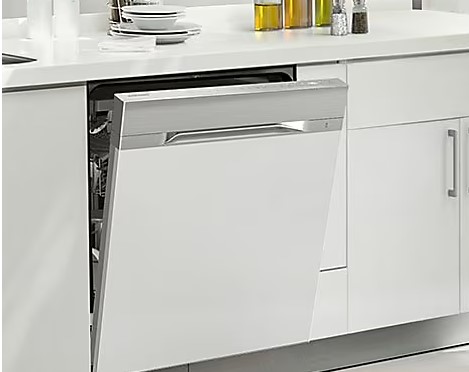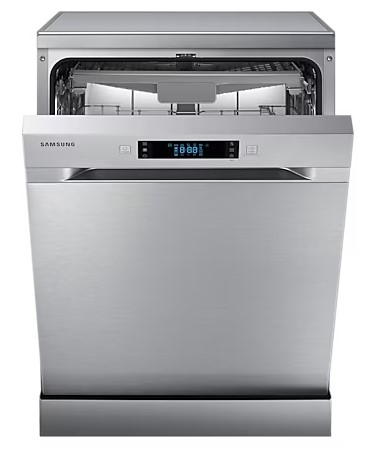Samsung dishwashers have different error codes, which pop up to alert you of a fault. One such code that may pop up is the Samsung dishwasher error code LE.
The LE error code is a leak detection error. It appears when the Samsung dishwasher leak sensor senses a leak due to a loose water supply hose, drain hose clogging, poor leveling, dish overload, excess suds, or clogging, among other issues.
There are about 11 possible explanations for the leak detection, which I’ll share with you. Note, however, that sometimes the error pops up for a non-leak issue, such as when using the dishwasher in a wet area or when an essential component like the heating element, pressure switch, or leak sensor malfunctions.
So, you may have to go beyond the 11 leak-related issues to clear this error code, and I’ll help you do it by discussing all the possible triggers. But first, let me explain the meaning of the LE error code on your dishwasher.

In a rush? Below is a quick troubleshooting guide for the LE fault code on your Samsung dishwasher
Quick Samsung Dishwasher LE Error Code Fix
| – | Likely Cause | Fix |
| 1. | Loose water supply hose | Fix the water supply hose if it’s loose and leaky. |
| 2. | Drain hose clogging | Unclog the drain hose. |
| 3. | Poor leveling | Level the dishwasher |
| 4. | Dish overload | Rearrange the dishes without overloading them. |
| 5. | Excess suds | Use the correct detergent (not dish soap) and the right amount. |
| 6. | Dishwasher clogging | Clean the dishwasher, more so the filter, water nozzles, and spray arms |
| 7. | Incorrectly stretched tub sides | Reinstall the tub sides properly. |
| 8. | Leaky door seal | Clean the door seal if it’s clogged, but replace it if it’s damaged. |
| 9. | Leaky water tank | Properly position the water tank supporting bolts but replace the tank if damaged. |
| 10. | Faulty water inlet valve | Replace the dishwasher’s inlet valve if it lacks continuity. |
| 11. | Defective circulation pump | Replace the circulation pump. |
What Does the Samsung Dishwasher Error Code LE Mean?
The error code LE, which may also appear as LC on some models, is a leak detection error. That means your Samsung dishwasher has detected a possible water leak, which you should identify and replace.
In Waterwall models, nevertheless, the error code LE may mean a blocked water reflector. We’ll, however, concentrate on leak detection, and here are possible causes:
1. Loose water supply hose
Due to an installation fault, the water supply hose may be loose. If so, the leak sensor may sense a leakage and trigger the LE error code.
2. Drain hose clogging
If the drain hose doesn’t allow water to drain off your dishwasher, the leak sensor will detect a possible leak because of unmoving water. In the end, the LE error code may pop up.
Here, the drain hose could be clogged because it’s improperly placed or kinked or due to too much food debris.
3. Poor leveling
Your dishwasher should be steady to allow water to come in and drain smoothly. If it’s unstable or unsteady, the chances are that water may splash, triggering the LE error code.
4. Dish overload
You shouldn’t put too many dishes in your dishwasher. If you do, there is the chance that some of the water may overflow, and when that happens, the leak detection sensor will sense that and trigger the LE error code.
5. Excess suds
A Samsung dishwasher leak detection sensor may read excess suds as a leakage because it contributes to a wet environment. That may happen from:
- Putting too much detergent
- Using the wrong detergent, such as dish soap instead of dish detergent

6. Dishwasher clogging
It’s imperative to clean your dishwasher as often as possible to eliminate food clogs and other debris. If you don’t, they may clog the drain filter, water nozzles, and spray arm, resulting in some form of leakage.
If the leak detector detects any leakage, even clog-related, the error code LE will pop up.
7. Incorrectly stretched tub sides
This could be a fault originating from a poor installation. It’s essential to stretch the tub sides when installing the dishwasher properly. Water may leak if you do it incorrectly, triggering the LE error code.
8. Leaky door seal
The door gasket or seal may sometimes leak from excess dirt, preventing it from maintaining a tight seal or damage. If so, that may prompt the error code LE to pop up.
So, check the door seal for dirt obstruction and damage if you suspect it could be leaky.
9. Leaky water tank
Another leaky component could be the water tank; if that’s the case, the error code LE will appear. The water tank may leak due to incorrectly positioned installation bolts or direct damage.
10. Faulty inlet valve
The dishwasher’s water inlet valve controls the water flowing into the dishwasher. If it’s faulty, the dishwasher may overfill, and when the leak sensor senses that, it’ll trigger the LE error code.
11. Defective circulation pump
Lastly, the issue behind the LE error code could be a non-working circulation pump. If the circulation pump doesn’t work properly, water may accumulate in the dishwasher to trigger the LE error code.
It could be that the circulation pump is excessively clogged or poorly damaged.
Samsung Dishwasher LE Code But No Leak
As I hinted earlier, sometimes the LE error code may pop up on a Samsung dishwasher due to a non-leak-related issue, and it could be any of the following:
- Wet surrounding – If you use the dishwasher in a wet surrounding, water may splash close to the leak sensor. If the leak sensor senses that, it may trigger the LE error code.
- Incorrectly attached drain cap – The drain filter cap should be firmly attached. The leak sensor may trigger the LE error code if it’s loose.
- Intact garbage disposal cap – You should remove the garbage disposal cap before running the dishwasher. If you don’t, it may instigate the LE error code.
- Defective leak sensor – Expect the leak sensor to malfunction if it’s faulty, and one sign is that it may prompt the error code LE.
- Defective pressure switch – If the pressure switch is faulty, it won’t be able to monitor the water level in the dishwasher, which means water may overflow and trigger the LE error code.
- Faulty heating element – Sometimes, the dishwasher displays the LE error code because the heating element won’t get the water hot for being defective.
- Defective control board – Lastly, you can expect your Samsung dishwasher to malfunction and display all kinds of error codes if the control board is faulty.

A Guide on How to Fix Samsung Dishwasher Error Code LE
Now that you know what to check when the LE error code appears on your Samsung dishwasher, here’s a 14-step guide to clearing it:
Step 1 – Run the dishwasher to identify any source of leakage
You must rule out any leakage, and one way to do that is to run a new cycle and see if you can detect any leakage source. If you can, fix it.
Step 2 – Give the dishwasher some time for the water to dry up
It could be that you are using the dishwasher in wet surroundings, and thus, water has splashed close to the leak detector. If so, you may need to allow the dishwasher some time for the water to dry out before reusing it.
Step 3 – Check the water supply hose for loose connection
If the water supply hose is loose, fix it properly. Remember, this is an installation fault, so you must be careful when setting the hose.
Step 4 – Inspect the drain hose for clogging
Check if the drain hose has any clog and unclog it. If there are kinks, straighten the drain hose and ensure it is appropriately placed to encourage good drainage.
Step 5 – Level the dishwasher
If your dishwasher is out of position or looks unleveled, level it up properly. Ensure it is uniform and steady when running.
Step 6 – Rearrange and reload the dishes
If the dishes are overloaded, remove them and rearrange them appropriately. Ensure you don’t overload them this time around.
Step 7 – Reduce detergent overuse or misuse
Check if there are too many suds; if that’s the case, avoid using too much detergent. And in case you are using dish soap, drop it and use dish detergent, preferably what Samsung recommends.
Step 8 – Clean the dishwasher
It could be that the dishwasher is heavily clogged, especially the filter, water nozzle, and spray arms. If so, clean the dishwasher correctly, preferably with Affresh dishwasher cleaner.
Step 9 – Check the tub sides for overstretching
If the tub sides are overstretched from a wrong installation, you should reinstall them correctly.
Step 10 – Check the door seal for clogging or damage
Clean any dirt obstruction on the door seal to ensure the seal is airtight. However, if the seal is damaged, replace it.
Step 11 – Inspect the water tank for leakage
If the water tank leaks, inspect it for loose connecting bolts and tighten them. However, if the issue is a damaged tank, replace it.
Step 12 – Test the water inlet valve for continuity
Use a handheld multimeter to test the water inlet valve. If the valve lacks continuity, it shows it’s defective, and you should replace it.

Step 13 – Inspect the circulation tank
Also, inspect the circulation tank for faults. It could be that it’s extra clogged or damaged. Try to clean the pump in the first case and replace it in the second case.
Step 14 – Check other components for fault
Lastly, consider that the leak sensor, pressure switch, heating element, or control board could be faulty. If so, you must replace it to fix the LE error code.
Samsung Dishwasher LE Error Code Reset
Sometimes it may help to reset the dishwasher, and the LE error code may clear. Here’s how to do it:
- Turn off the dishwasher and plug it out
- Wait for 1-5 minutes to plug it back in and power it on
- See if the fault code will reappear, and if it does, consider the 14-step guide shared above
Concluding Thought on Samsung Dishwasher Error Code LE:
Generally, inspecting your Samsung dishwasher for possible leakage when the LE error code pops up is best. That includes loose water supply hose, drain hose clogging, poor leveling, dish overload, excess suds, clogging, incorrectly stretched tub sides, leaky door gasket or water tank, or a faulty inlet valve or the circulation pump.
Also Read:
